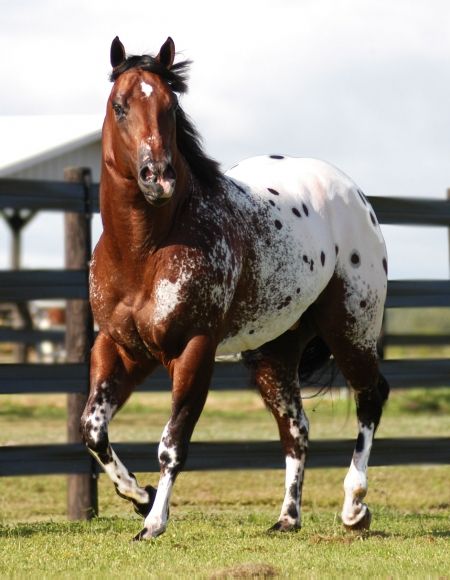Horses

El fenómeno de color que distingue al caballo appaloosa se encuentra en la base genética de los caballos primitivos. Aparece, por ejemplo, plasmado en pinturas rupestres que datan de hace más de 20.000 años, como las de Peche-Merle, Francia.
En la antigua Persia se tenía un gran aprecio a estos caballos moteados y los consideraban como los caballos sagrados de Nicea.
En China se usaron estos caballos desde el 100 a. C. para la guerra, desplazando así al pequeño caballo centroasiático. A partir del siglo VII se les encuentra en artículos de arte, reconociéndose así el gusto que los chinos tenían por estos caballos.
En Europa los caballos moteados aparecen a través de la historia, abundando más entre los caballos españoles y lippizanos.
En América era común ver el color punteado entre los caballos españoles de los conquistadores del siglo XVI, por lo que cabe suponer que el origen del caballo appaloosa no es otro que el caballo español de una capa determinada, que empezó a ser seleccionado probablemente por los indios Nez Perce que vivían en la región noroeste de lo que hoy son los Estados Unidos, en los estados actuales de Washington y Oregón.
Fueron los Nez Perce quienes vieron en este caballo el prototipo de animal que buscaban para sus actividades de caza y guerra, en particular por su color, nobleza, versatilidad y fortaleza de estructura. Fueron más de 200 años de una práctica cuidadosa de selección de los caballos, usando para la reproducción solo los mejores representantes de la raza ideal que deseaban. Es así que fijaron genéticamente los elementos que distinguen hoy en día al appaloosa. El nombre de la raza appaloosa proviene del río Palouse, que atravesaba la región habitada por los Nez Perce.cuando veían un caballo moteado , se decía que " era un caballo del río Palousse " ( a palousse river horse )y de allí quedó en appaloosa Hoy día se acepta de manera más precisa que el origen del caballo appalloosa esta en el área formada por los ríos Palouse, Snake i Clearwater todos en el norte de Idaho-USA, y que se corresponde con el Nez Perce National Forest. Piezas de cerámica, como esta de principios de la era cristiana, muestran el gusto de los chinos, especialmente en la dinastía Ming, por la capa tan representativa del moderno appaloosa
The color phenomenon that distinguishes appaloosa horse is found in the genetic basis of primitive horses. It appears, for example, embodied in cave paintings dating back more than 20,000 years, such as those of Peche-Merle, France.
In ancient Persia, these mottled horses were highly esteemed and regarded as the sacred horses of Nicaea.
In China these horses were used from 100 a. C. for the war, thus displacing the small Central Asian horse. From the seventh century they are found in art items, thus recognizing the taste that the Chinese had for these horses.
In Europe mottled horses appear throughout history, abounding more between Spanish horses and lippizanos.
In America it was common to see the dotted color among the Spanish horses of the sixteenth century conquerors, so it can be assumed that the origin of the appaloosa horse is none other than the Spanish horse of a certain layer, which probably began to be selected by the Nez Perce Indians who lived in the northwest region of what is now the United States, in the current states of Washington and Oregon.
It was the Nez Perce who saw in this horse the prototype of animal that they looked for their hunting and war activities, in particular for their color, nobility, versatility and strength of structure. They were more than 200 years of careful practice of selection of horses, using for reproduction only the best representatives of the ideal race they wanted. This is how they genetically set the elements that distinguish appaloosa today. The name of the Appaloosa breed comes from the Palouse River, which crossed the region inhabited by the Nez Perce. When they saw a mottled horse, it was said that "it was a horse of the river Palousse" (a palousse river horse) and from there it was appaloosa Today it is more accurately accepted that the origin of the appallous horse is in the area formed by the Palouse, Snake and Clearwater rivers all in the north of Idaho-USA, and that corresponds to the Nez Perce National Forest. Ceramic pieces, such as the early Christian era, show the taste of the Chinese, especially in the Ming dynasty, by the coat so representative of the modern appaloosa